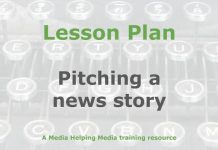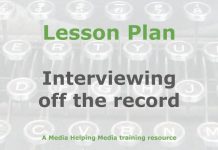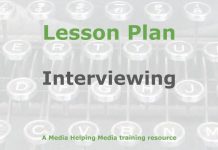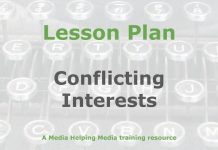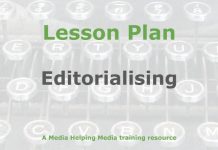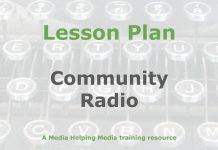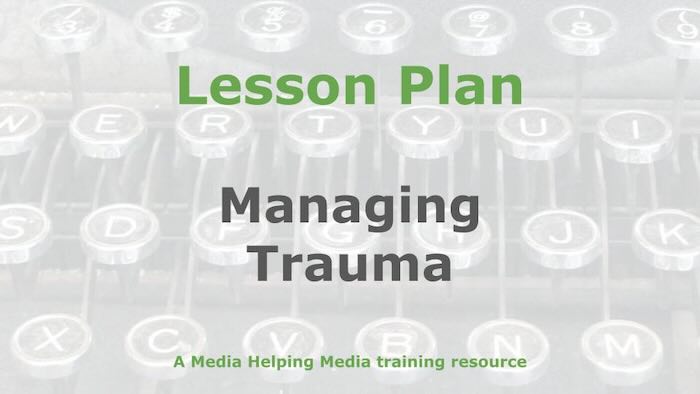 This lesson plan is designed to help journalism students understand the issues of trauma, stress and post-traumatic stress disorder (PTSD) in the context of journalism.
This lesson plan is designed to help journalism students understand the issues of trauma, stress and post-traumatic stress disorder (PTSD) in the context of journalism.
It’s based on the article ‘Journalism, trauma, and stress‘ which we recommend trainers read before adapting this lesson outline for your own purposes.
Introduction
Journalism, as a profession, often demands that individuals bear witness to some of humanity’s most challenging and traumatic events. Whether covering natural disasters, conflicts, or personal tragedies, journalists are exposed to experiences that can have a profound impact on their mental and emotional well-being, leading, in some cases to post-traumatic stress disorder (PTSD). This course, “Managing Trauma” aims to equip aspiring and practicing journalists with the knowledge and skills necessary to navigate these challenges responsibly and ethically. We will explore the psychological effects of trauma, examine ethical considerations in reporting, and cultivate strategies for self-care and organisational support. To begin, it is essential that all students familiarise themselves with the Dart Center’s article “Covering trauma: Impact on journalists” and the article published on Media Helping Media (MHM) “Journalism, trauma and stress“. These documents provide a foundational understanding of the issues we will be addressing throughout this course, and will prepare you for the first session.
Session 1: Introduction to trauma and journalism (2 hours)
- Introduction (30 minutes):
- Course overview and objectives.
- Defining trauma and its relevance to journalism.
- The historical dismissal of journalists’ trauma.
- Discussion: The shift in awareness and the need for training.
- Exposure and impact (45 minutes):
- Review of Dart Centre and MHM texts outlining the issues.
- Discussion of cumulative exposure and its effects, potentially drawing on examples from the MHM article.
- Exploring the range of traumatic events journalists encounter such as accidents, wars, and monitoring user-generated content (UGC).
- Guidelines and awareness (45 minutes):
- Introduction to international guidelines issued by the UK’s National Union of Journalists (NUJ) and and the Committee to Protect Journalists (CPJ).
- Post traumatic stress disorder (NUJ) – https://www.nuj.org.uk/advice/health-and-safety/ptsd.html
- Covering the news in a dangerous and changing world (CPJ) – https://cpj.org/reports/2012/04/stress-reactions/
- Discuss the importance of recognising PTSD as a real issue.
- Identifying potential trauma-inducing situations.
- Introduction to basic coping mechanisms.
- Introduction to international guidelines issued by the UK’s National Union of Journalists (NUJ) and and the Committee to Protect Journalists (CPJ).
Session 2: Recognising and managing stress (2 hours)
- Signs and symptoms of stress (45 minutes):
- Detailed examination of the signs of stress as set out on MHM.
- Discussion of emotional, physical, and behavioural symptoms as set out on MHM.
- Case studies and examples.
- Control measures and coping strategies (45 minutes):
- Review of the BBC’s guidelines on managing stress – https://www.bbc.co.uk/safety/resources/aztopics/trauma-and-ptsd
- What is trauma – https://downloads.bbc.co.uk/safety/documents/health/safety-what-is-trauma.docx
- Practical strategies: sleep, exercise, routines, communication, reflection.
- Discussion of the danger of self medicating with drugs and alcohol.
- After the event: Debriefing and support (30 minutes):
- Introduction to the IFJ’s “Survival Guide For Journalists” (Chapter 6) – https://www.ifj.org/fileadmin/images/Live_News_versions/Live_News_EN.pdf
- The importance of debriefing and professional counselling.
- Addressing the “macho culture” and encouraging help-seeking.
Session 3: Ethical dilemmas and reporting on trauma (2 hours)
- Ethical frameworks (45 minutes):
- Discussion of the Dart Center’s study on trauma and ethical impact.
- Review of MHM’s resources on editorial ethics.
- Why editorial ethics are important – https://mediahelpingmedia.org/ethics/why-editorial-ethics-are-important/
- Fairness – https://mediahelpingmedia.org/ethics/fairness-in-journalism/
- Accuracy – https://mediahelpingmedia.org/ethics/accuracy-in-journalism/
- Privacy – https://mediahelpingmedia.org/ethics/respecting-privacy-as-a-journalist/
- Impartiality – https://mediahelpingmedia.org/ethics/impartiality-in-journalism/
- Unconscious bias – https://mediahelpingmedia.org/ethics/unconscious-bias-and-its-impact-on-journalism/
- Ethical challenges in traumatic situations (45 minutes):
- Balancing public interest with victim privacy.
- Journalism and the public interestt (MHM) – https://mediahelpingmedia.org/basics/applying-the-public-interest-test-to-journalism/
- Reporting on suffering and graphic content.
- The impact of digital dissemination and UGC.
- Review of scenario based MHM links.
- Right of reply and accuracy scenario – https://mediahelpingmedia.org/scenarios/right-of-reply-and-accuracy-scenario/
- Privacy protection scenario – https://mediahelpingmedia.org/scenarios/privacy-protection-scenario/
- Covering a tragedy scenario – https://mediahelpingmedia.org/scenarios/covering-a-tragedy-scenario/
- Photojournalism scenario – https://mediahelpingmedia.org/scenarios/photo-journalism-scenario/
- Balancing public interest with victim privacy.
- Victims and audience impact (30 minutes):
- The potential for repeating traumatisation.
- The effects of traumatic media exposure on the public.
- The importance of responsible and empathetic reporting.
Session 4: Organisational responsibilities and support (2 hours)
- Culture of care (1 hour):
- The moral and ethical responsibility of news organisations.
- Implementing proactive support systems.
- Creating safe spaces and peer support networks.
- Legal obligations regarding employee mental health.
- Discussing Flexible work arrangements.
- Guest speaker (1 hour):
- Invite a journalist or mental health professional specialising in trauma and journalism.
- Share personal experiences and insights.
- Questions and answers (Q&A) session with students – see suggested Q&As on MHM – https://mediahelpingmedia.org/advanced/journalism-trauma-and-stress/#QandA
Session 5: Personal strategies and resilience (2 hours)
- Self-care and mindfulness (1 hour):
- Practical strategies for prioritising self-care: sleep, nutrition, exercise.
- Introduction to mindfulness and meditation techniques.
- Building strong social support networks.
- Discussing the importance of validating emotional responses.
- Developing resilience (1 hour):
- Focusing on survivor resilience and strength.
- Amplifying marginalised voices.
- Reporting with sensitivity and respect.
- Recognising the human cost of every story.
- Discussion of existential questioning, moral injury, and loss of empathy.
Session 6: Future of journalism and trauma (2 hours)
- Education and training (45 minutes):
- The role of journalism schools in preparing students.
- Integrating trauma awareness into curriculum.
- Creating a culture of open dialogue about mental health.
- Review and discussion (45 minutes):
- Recap of key concepts and strategies.
- Open discussion on the future of journalism and trauma.
- Student reflections and questions.
- Final projects/presentations (30 Minutes):
- Students present final projects, or short presentations, on a chosen area of study from the course.
Summary:
This course comprehensively explores the critical intersection of trauma, ethics, and resilience in journalism. Through six sessions, students will gain a deep understanding of the psychological impact of bearing witness to traumatic events, the ethical complexities of reporting on such events, and the importance of self-care and organisational support. By integrating insights from leading organisations and experts, this curriculum aims to equip journalists with the tools necessary to navigate the challenges of their profession while maintaining their well-being and upholding the highest standards of journalistic integrity.
